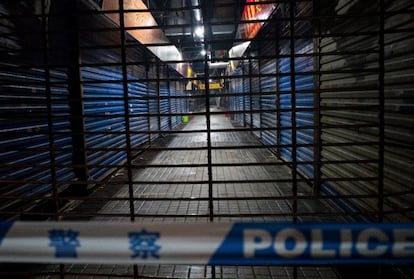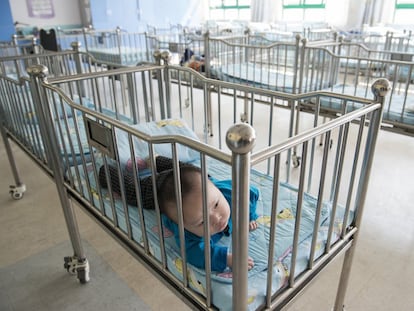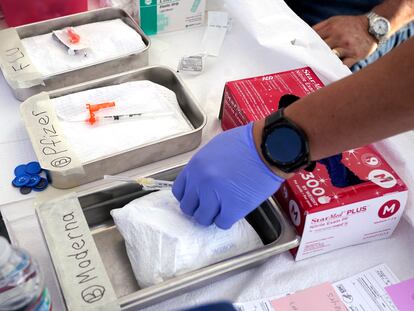Raccoon dogs, pangolins, a lab leak: Covid-19 origins divide US intelligence agencies and scientists
More than three years after the start of the coronavirus pandemic there is no definitive answer as to the source of the outbreak, although the FBI points to a lab leak in Wuhan


It has been three years and four months since the city of Wuhan, then little-known outside of China, began to detect the first cases of a strange virus that would subsequently bring practically the entire planet to a halt. The origin of Covid-19 remains a mystery, although plenty of theories abound, fueled by a debate that has become more political than scientific amid Beijing’s reluctance to allow the United Nations full access. The latest thread of the investigation into how the coronavirus made the leap from animals to humans points to the common raccoon dog, a species native to East Asia that was present in the Huanan wet market from where the virus is believed to have emerged.
The climate for impartial research has been far from conducive. The World Health Organization (WHO) has reproached the Chinese government for a lack of transparency in providing essential data to try to prevent a repetition of such a devastating outbreak. Precisely where and how the virus jumped to humans remains a bone of contention between Beijing and Washington, where the subject still occupies the time the intelligence agencies and congressional hearings.
On April 18, a group of experts who were initially tasked with analyzing the origin of SARS-CoV-2 will appear before a congressional sub-committee to deliver their opinions on “the role of China in the origins of Covid-19″ and to lay out where the intelligence community currently stands on the subject. It will be the second such hearing in the U.S. Congress so far this year, and more are expected. President Joe Biden has signed a bill to declassify what his secret services know about the emergence of the novel coronavirus. An investigation ordered last year failed to produce conclusive results, and the agencies tasked with providing answers have so far been unable to reach a consensus.
Of all possible theories, the most widespread among scientists is that Covid-19 was the result of a zoonosis — a jump from an animal, in this case most probably a bat, to humans via a third species, possibly a pangolin. This could have occurred in the wild, on a farm, or in the Huanan market, where 653 stalls sold animals of all kinds — live, dead, domestic, and wild — crammed together in unhygienic conditions. Another theory, supported by some U.S. government agencies including the FBI, points to a leak from a laboratory in Wuhan. Beijing, on the other hand, has pointed the finger at a U.S. military base in Maryland, Fort Detrick, located around 50 miles north of Washington D.C., which in China is as widely accepted by the population as the Wuhan leak is in the U.S. The U.S. Energy Department recently stated that a classified report had determined, albeit with a low degree of confidence, that Covid-19 had leaked from a laboratory.
While the FBI and the Energy Department have inclined toward the laboratory theory, at least four other official agencies in the U.S. are leaning toward a conclusion of natural causes while two more involved in the investigation have not produced their findings. The only common ground is that none of them have much confidence in their respective theses or any solid evidence to support them. On March 13, WHO Director-General Tedros Adhanom Ghebreyesus, who has always erred on the side of caution when speaking about Beijing and the Covid-19 pandemic, told a conference: “More than three years after this outbreak started, we still don’t know how, due to a lack of cooperation from China to be transparent in sharing data, and to conduct the necessary investigations and share the results.”
China has been reluctant to publicize the data it holds on the origin of the disease. The first details of Covid-19′s genome was shared with the world, but only through the personal initiative of the doctors who did so. A first WHO mission to China was permitted to visit Wuhan very briefly, but did not have access to the Huanan market or to the first patients affected.
A second WHO team made up of international scientists who had been approved by Beijing arrived in January 2021 to considerable fanfare. These experts were able to visit hospitals and talk to patients as well having access to the Huanan market and former traders who ran food stalls there. But after leaving China, they acknowledged that their work had been carried out under enormous constraints and the Chinese health authorities — who were by their side throughout the fact-finding mission — had not provided them with the raw data they had requested on the first Covid-19 patients.
The common raccoon dog theory
Since then, there have been no further WHO visits to China and it does not appear there will be any in the foreseeable future. Even the latest theory was the result of a fluke. A group of scientists from the Chinese Center for Disease Control and Prevention published a series of genomic data found in samples taken from the Huanan market on a public archive called GISAID. The data was deleted almost immediately by the publishers themselves but by then a French scientist, Florence Debarre, had managed to download the information and a group of Western experts set to work on it.
The team, which included University of Arizona ecologist Michael Worobey, found raccoon dog genetic material in several samples taken from Huanan, including some from a shopping cart and a poultry plucking machine. These samples were located in a very specific area of the market where wild animals were being sold. The samples themselves do not prove that this animal, which is extensively farmed for its fur, was responsible for the virus jumping to humans but they do close the circle around Huanan, which has been closed since the pandemic broke out, a little tighter.
However, the laboratory leak theory cannot be completely ruled out either, given the opacity that surrounds the data. It is a theory that some Chinese scientists backed before it was ruled out, at least in official terms: when the first Covid-19 cases were detected in December 2019, a Chinese expert on bat viruses, Shi Zhengli — nicknamed Batwoman due to her extensive knowledge of the animals — suspected that the coronavirus could have escaped from the laboratory where she worked, the Wuhan Institute of Virology, which is just a few miles from the Huanan market. Although she herself acknowledged as much in March 2020 in the journal Scientific American, she also noted that she had ruled out the possibility after running checks.
The laboratory leak theory also has precedents. In 2004, the WHO expressed its concern after two researchers at the National Institute of Virology in Beijing were infected with the SARS virus, one of them becoming ill in March of that year: China covered up the incident for almost a month.
Sign up for our weekly newsletter to get more English-language news coverage from EL PAÍS USA Edition
Tu suscripción se está usando en otro dispositivo
¿Quieres añadir otro usuario a tu suscripción?
Si continúas leyendo en este dispositivo, no se podrá leer en el otro.
FlechaTu suscripción se está usando en otro dispositivo y solo puedes acceder a EL PAÍS desde un dispositivo a la vez.
Si quieres compartir tu cuenta, cambia tu suscripción a la modalidad Premium, así podrás añadir otro usuario. Cada uno accederá con su propia cuenta de email, lo que os permitirá personalizar vuestra experiencia en EL PAÍS.
¿Tienes una suscripción de empresa? Accede aquí para contratar más cuentas.
En el caso de no saber quién está usando tu cuenta, te recomendamos cambiar tu contraseña aquí.
Si decides continuar compartiendo tu cuenta, este mensaje se mostrará en tu dispositivo y en el de la otra persona que está usando tu cuenta de forma indefinida, afectando a tu experiencia de lectura. Puedes consultar aquí los términos y condiciones de la suscripción digital.
More information
Archived In
Últimas noticias
Most viewed
- Oona Chaplin: ‘I told James Cameron that I was living in a treehouse and starting a permaculture project with a friend’
- Sinaloa Cartel war is taking its toll on Los Chapitos
- Reinhard Genzel, Nobel laureate in physics: ‘One-minute videos will never give you the truth’
- Why the price of coffee has skyrocketed: from Brazilian plantations to specialty coffee houses
- Silver prices are going crazy: This is what’s fueling the rally










































